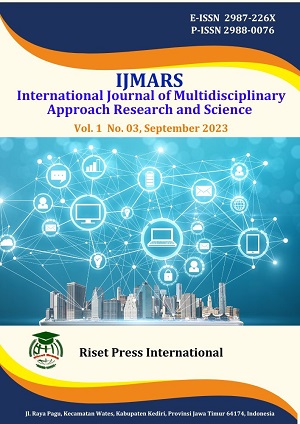Tracing the Interests of Indonesian Khonghucu Adherents, Between Business and Academia
DOI:
https://doi.org/10.59653/ijmars.v1i03.242Keywords:
interest, Konghucu adherent, business, academic, valueAbstract
This study aims to examine the interests of Indonesian Khonghucu religious adherents, especially related to business and academia. The people of Khonghucu are known to be very good at doing business, so they are generally financially successful. Since obtaining legality since the time of President K.H. Abdurrahman Wahid, Khonghucu has now continued to develop. Among Khonghucu businessmen, are there those who choose to become academics, pursue religion more, and develop Khonghucu? This study used a descriptive qualitative approach with phenomenological methods. The informan was a Khonghucu adherent who had succeeded in becoming a businessman and academic. Data collection techniques are carried out by interviews, observation, and documentation studies. Data validation is done by triangulation, both technique triangulation and source triangulation. The results showed that Khonghucu adherents in Indonesia are very interested in becoming entrepreneurs, although some of them prefer academic careers. Both options are influenced by family culture and values, labor market opportunities and demands, the influence of the educational environment and personal aspirations and abilities of individuals. Those in business contribute to Indonesia's economy, while those who choose academia preserve and pass on Confucian religious traditions to future generations. Both those who choose business and academia recognize that pursuing religion is a valuable devotion for Confucians and Indonesian society as a whole.
Downloads
References
Ahmad, M. I. (2021). Pola Adaptasi Mahasiswa Baru Dalam Meraih Prestasi Akademik (Studi Kasus Adaptasi Mahasiswa China di UIN Maulana Malik Ibrahim Malang). Journal TA’LIMUNA, 10(1). https://doi.org/10.32478/talimuna.v10i1.479
Aprilia, S., & Murtiningsih. (2017). Eksistensi Agama Khonghucu Di Indonesia. Eksistensi Agama Khonghucu Di Indonesia Pemerintah, 1(1).
Asriyanti, C. D., Isnaini, R. F., & Utomo, J. P. (2020). Fasad arsitektur cina pada kawasan pecinan masa kini. Seminar Ilmiah Arsitektur, 8686.
Emma Nurmawati Hadiana, & Wakhudin. (2022). Relasi Guru Agama Khonghucu dengan Masyarakat di Indonesia. Jurnal Multidisiplin Madani, 2(6). https://doi.org/10.55927/mudima.v2i6.550
Emsan. 2018. Bisnis Sukses ala Tiongkok, India, & Arab. Penerbit Laksana, Yogyakarta.
Gondomono, G. (2015). Masyarakat dan kebudayaan Cina. Wacana, Journal of the Humanities of Indonesia, 4(1). https://doi.org/10.17510/wjhi.v4i1.258
Hadi, S. (2020). Lasem: Harmoni dan Kontestasi Masyarakat Bineka. ISLAM NUSANTARA: Journal for Study of Islamic History and Culture, 1(1). https://doi.org/10.47776/islamnusantara.v1i1.49
Hartati, D. (2016). Konfusianisme dalam Kebudayaan Cina Modern. Paradigma, Jurnal Kajian Budaya, 2(2). https://doi.org/10.17510/paradigma.v2i2.25
In memoriam Peter F. Drucker (1909-2005). (2005). Journal of East European Management Studies, 10(4). https://doi.org/10.5771/0949-6181-2005-4-328
Kristi, V., & Setiawan, T. (2023). Regenerasi Lingkungan Cina Benteng di Jalan Cilame. Jurnal Sains, Teknologi, Urban, Perancangan, Arsitektur (Stupa), 5(1). https://doi.org/10.24912/stupa.v5i1.22628
Michael Justin Lee. 2013. Jadi Kaya Cara China. Bhuana Ilmu Populer. Jakarta.
Perdana, Y., & Ishak, M. (2018). Pengaruh Arsitektur Kebudayaan Cina Terhadap Morfologi Klenteng Toa Se Bio Di Glodok Jakarta Barat. Urbanisasi Dan Pengembangan Perkotaan.
Putro & Hadian. 2017. Peta Umat Agama Khonghucu di Indonesia: Mencari Model Pelayanan Sesuai Kebutuhan Umat -- Studi Kasus Umat Khonghucu Purwokerto. Puslitbang Bimas Agama dan Layanan Keagamaan Badan Litbang dan Diklat Kementerian Agama RI (Tidak Dipublikasikan).
Shanti, D. R., & Rusyanti, R. (2021). Dilema Etnis Tionghoa di Indonesia. Prosiding Balai Arkeologi Jawa Barat. https://doi.org/10.24164/prosiding.v4i1.25
Sunandar, S. (1970). Keunggulan Manajemen Gaya Jepang, Korea Selatan, Cina, Amerika Serikat Dan Indonesia Sebagai Tolak Ukur Persaingan Bisnis Di Era Globalisasi. Fokus Bisnis : Media Pengkajian Manajemen Dan Akuntansi, 13(1). https://doi.org/10.32639/fokusbisnis.v13i1.14
Wibowo, G. A. (2017). Ekonomi Etnis Cina Di Surakarta Selama Orde Baru. Jurnal Seuneubok Lada, 4(1).
Downloads
Published
How to Cite
Issue
Section
Categories
License
Copyright (c) 2023 Emma Nurmawati Hadian, Wakhudin Wakhudin

This work is licensed under a Creative Commons Attribution-ShareAlike 4.0 International License.
Authors who publish with this journal agree to the following terms:
- Authors retain copyright and grant the journal right of first publication with the work simultaneously licensed under a Creative Commons Attribution-ShareAlike that allows others to share the work with an acknowledgement of the work's authorship and initial publication in this journal.
- Authors are able to enter into separate, additional contractual arrangements for the non-exclusive distribution of the journal's published version of the work (e.g., post it to an institutional repository or publish it in a book), with an acknowledgement of its initial publication in this journal.
- Authors are permitted and encouraged to post their work online (e.g., in institutional repositories or on their website) prior to and during the submission process, as it can lead to productive exchanges, as well as earlier and greater citation of published work (See The Effect of Open Access).
























